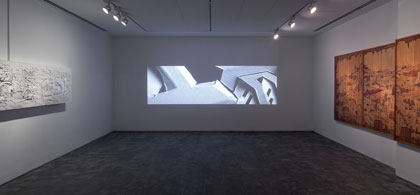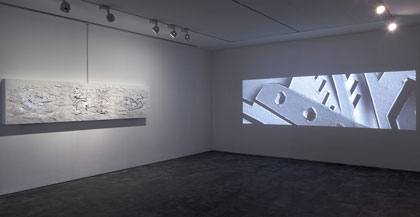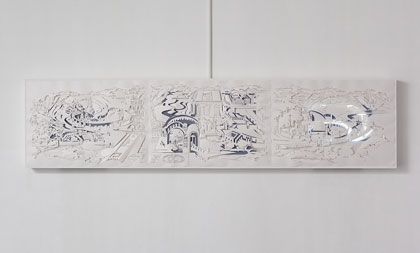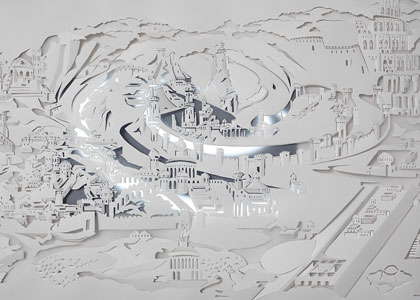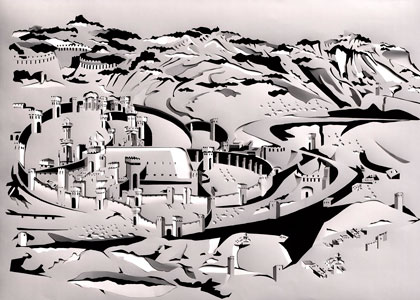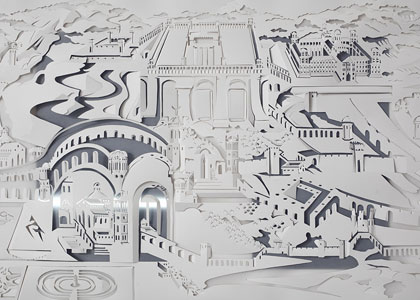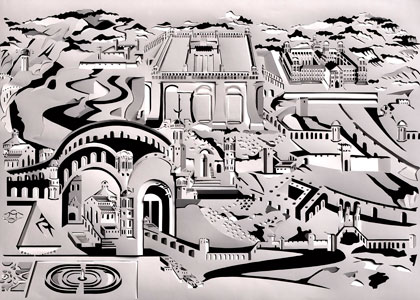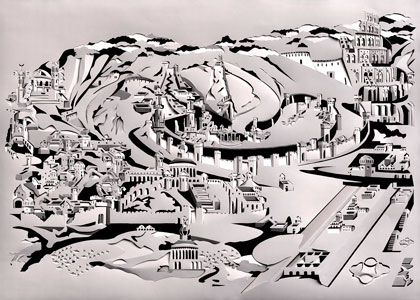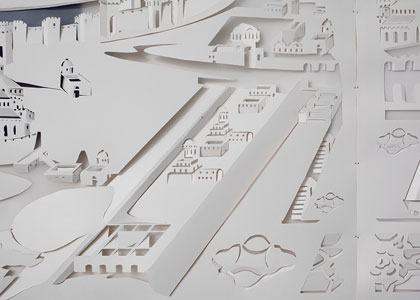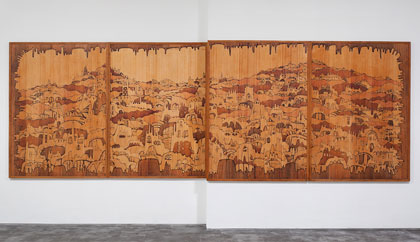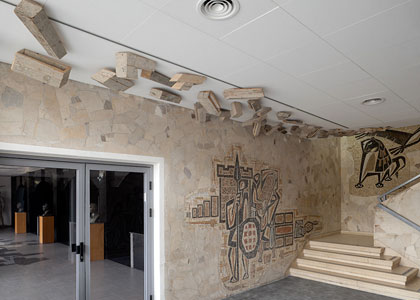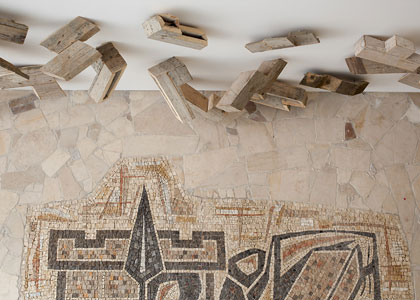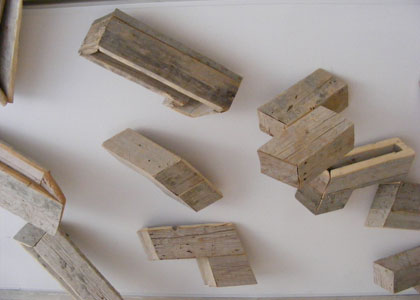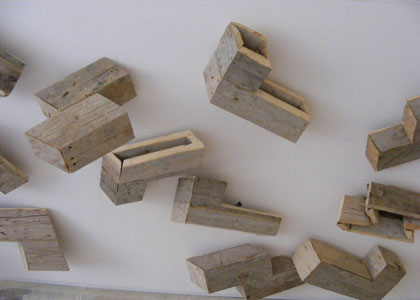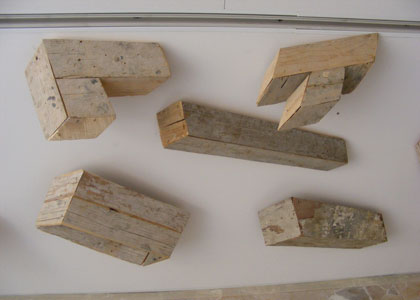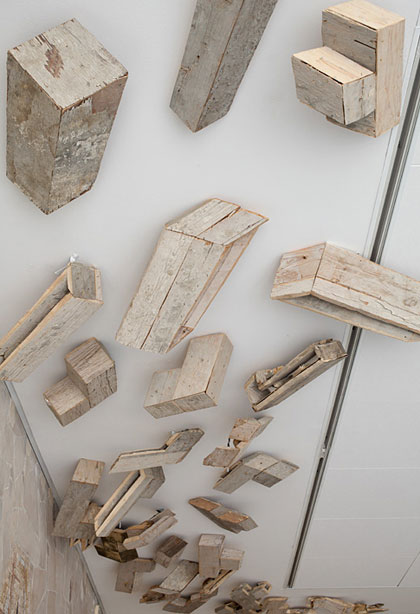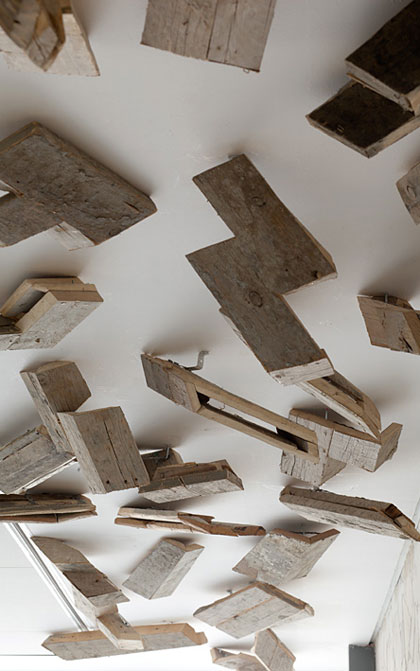Flood
Curator: Irit Carmon Popper
09/02/2012 -
09/06/2012
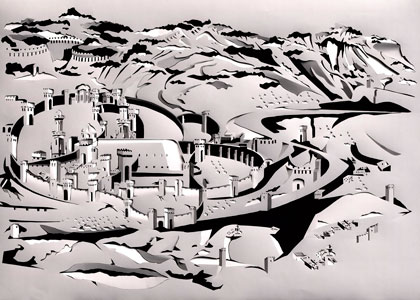
“Flood,” the third in the series of exhibitions “Continuum: Installations following the Collection,” continues its practice of inviting pairs of artists to create intertextual tributes in the form of site-specific installations which observe and incorporate works from the Museum’s collection (as a point of departure and a source of inspiration). Peleg Dishon’s spatial installation in the gallery converses with Talila Ben Porat’s work Jerusalem (1976); next to it, in the foyer of the Yad Labanim Museum, is a ceiling installation created by Ra’anan Harlap facing Mordechai Gumpel’s mosaic wall With One Hand Laboured on the Work (1965-66).
The title of the exhibition draws on the metaphoric denotation of “flood” as profusion and excessive multiplicity, referring to an act of inundation, gush or drift, in this case—an inundation of viewpoints, perspectives, and perceptions. This notion invokes the “theory of the Derivé” introduced by Guy Debord and the Situationists in the 1950s, essentially centered on “transient passage through varied ambiences” to create an alternative geography, a wandering which brings to the surface the psychological order hidden beneath the explicit order of the city. The Situationists’ proposed architecture is based on constant interference with orientation and a new perception of space.1 In this sense, “flood” refers to intervention in the Euclidean spatial perception in the exhibition and its replacement with a simultaneity of viewpoints, which displaces the perspectival vanishing point in favor of a discussion of the feasibility of new spaces.2 The installations created by Dishon and Harlap expose a multiplicity of viewing modes and perceptions of reality vis-à-vis the accelerated technological development and the changes in the perception of space-time today. The limited (even false) nature of the gaze is reinforced against dimensions beyond the grasp of the human eye.
Ra’anan Harlap’s ceiling installation consists of readymade materials (planks, leftover construction material), which together form structures reminiscent of Tetris blocks. The blocks are generated by various combinations of four identical squares of the type which, during the eponymous computer game, drop from the top of the screen so as to thereby fill a row at the bottom. The game is based on three-dimensional solid geometry which undergoes two-dimensional flattening in its transition to the screen—and that is the condition that makes it possible, for only in two-dimensional form can the shapes be placed in a single row. Enhancement of the planeness and the objects’ flattening, alongside the abstraction involved, entails a change in spatial perception and a rearrangement of the territory, when the dimensions of the physical space collapse and “disappear” on the computer screen.3 Harlap extracts these blocks from the abstracting cybernetic trap, furnishing them with a renewed physical presence, although with perspectival distortion—a type of optical shift manifested in the object’s morphology. In this context, it is interesting to mention anamorphoses, a distortion of an image familiar from Hans Holbein’s well-known painting, The Ambassadors (1533)—a phenomenon which captures the viewer split between two gazes, frontal and lateral, where each observation post necessarily contains a loss of the image, and with it—an undermining of the viewer’s autonomous sovereignity.4
The installation is placed on the ceiling as an elongated, twisted concentration of mass gradually dispersing from within itself, calling to mind an object caught in a black hole in which time is slowed, converting its mass into kinetic energy.5 The cyclical movement sweeps the blocks in directions which deviate from the vertical-horizontal axis customary in the game, making the viewer feel as though he is pulled inside from the entrance door to the foyer, reinforcing the perception of the place as a passage which, by definition, demands swift movement. The amorphous, cyclical movement reinstates the object with the characteristics of natural flood, which are inverse to the static and constructivist qualities of the mosaic decorating the foyer walls; in their materiality and shape, the wooden blocks are actually congruent with and continue the structurality of the mosaic wall and the image featured in it.
Peleg Dishon’s spatial installation manifests architectural elements of a basilica: an elongated nave, flanked by aisles and an apse at the end—the area of the sacred altar. The aisles contain the suspended plates of Talila Ben Porat’s double diptych Jerusalem opposite a landscape created by Dishon as a paper cutout which oscillates between map and model, with four screens simulating an act of scanning situated behind it. The “apse,” as befitting its significance, contains a monumental projection of the scans—enlarged views of the map-landscape’s verso, its invisible back side—a projection which generates an illusion of space despite its being flat and impenetrable whether by the sight lines or by the viewer. In this projected space of visual collapse, interior becomes exterior (surface), blurring the differences between near and distant, real and imaginary, three-dimensional and two-dimensional.
The paper cutout results from combination of multiple different landscape images inspired by the wood work to which the artist chose to relate, and from his visual and mental impressions of the city of Jerusalem and its images. For their presentation, Dishon uses a multi-layered construction of multiplicity to create a type of augmented reality which does not masquerade as a unified unit. Among the images one may identify Bruegel’s Tower of Babel, an ancient map of the celestial Jerusalem, depictions of cities and castles by Dürer and Böhm, the cover of the LP record “Relayer” by Yes. The upper border of the landscape was borrowed from the skyline of the Jerusalem hills in Ben Porat’s work—evolving-dynamic landscapes consisting of excerpts of architecture and nature repeated densely, almost obsessively, in a manner reminiscent of art brut. The spatial totality created by Dishon is marked by a different type of spatial movement, one which blends real and utopian architectural structures regardless of their historical-geographic location, with wriggly resilient psychogeographical wandering routes flowing between them, flooding the landscape. Cut and folded, these routes are absent spaces, empty like black holes, whose significance lies, paradoxically, in the light passing through them, connecting the static map parts.
Dishon’s invented landscape juxtaposes panoramic and geological views, distant and close-up, external and internal. This simultaneity produces a gaze which hangs by a thread on the verge of collapsing; the inversion of the gaze and interference with the ground position eliminate the dimension of depth. The spatial disorientation occurs when the viewer moves simultaneously between a broad linear gaze and an inquisitive close-up, in an attempt to follow the occurrence of a lateral, cyclic, or flowing movement from top to bottom; between an overview and a concentration on detail; between surface and interior. As in the New Babylon of Situationist architect and painter Constant Nieuwenhuys—a utopian project which called for an atmosphere-dependent architecture requiring the mobility of structures and spaces—Dishon assembles and deconstructs places, periods, and styles to produce a new Jerusalemite space, virtual and utopian, underpinned by stratification and flux between spaces and times.
“Jerusalem” as a concept and a construction, as a point of departure and a source of inspiration, is gauged in the exhibition as a case study—a stratified city whose radical multiplicity of (cultural and archaeological) layers distinguishes it from other cities, but at the same time—projects on them. It is in this conceptualization that Jerusalem bursts forth in the ceiling installation, when the shadow of the Tetris blocks projects on the mosaic figures busy building the wall of Jerusalem from the period of Nehemiah as a pile of orphaned geometrical forms awaiting their utopian realization.
Notes
1. See Guy Debord, Theory of the Dérive (1958), in Libero Andreotti and Xavier Costa (eds.), Theory of the dérive and other situationist writings on the city (Barcelona: Museo d’Art Contemporani, 1996); Mark Wigley, Constant’s New Babylon: The Hyper-Architecture of Desire (Rotterdam: 010 Publishers, 1998).
2. Scholar and architect Rem Koolhaas uses these terms to describe the “New Urbanism” in a space which is not based on order, but rather on uncertainty; which no longer aims for stable configurations, but rather refuses their crystallization; no longer obsessed with the boundaries of the city and its architectural contours, but with manipulation of infrastructure for endless intensifications and diversifications; see Rem Koolhaas, “Whatever Happened to Urbanism?”, in S, M, L, XL (New York: Monacelli Press, 1995), pp. 958-971.
3. See: Paul Virilio, The Aesthetics of Disappearance (New York: Semiotext[e], 1991); Dror K. Levi, “The Big Aphanisis: From Time to Space and Vice Versa,” History and Theory, 4 (March 2007), on-line magazine of the History and Theory Unit, Bezalel Academy of
Art and Design [Hebrew]; for an English synopsis see: http://bezalel.secured.co.il/zope/home/en/1173510036/dror_en.
4. See Ruth Ronen, “The Picture: A Trap for the Gaze,” Art and Its Discontents (Tel Aviv: Am Oved, 2010), p. 90 [Hebrew].
5. See Avi Rosen, “Art at the Event Horizon,” trans. Sonia Dantziger (the Department of Art History, Tel Aviv University, 2005), http://www.transmediale.de/en/node/5219.
Peleg Dishon, Flood, 2012, site-specific spatial installation, mixed media
Talila Ben Porat, Jerusalem, 1976, scorched and painted wood, four plates, 168×122 cm each, in memory of Yaacov Sammet
Ra’anan Harlap, Flood, 2012, site-specific ceiling installation, wood
Mordechai Gumpel, With One Hand Laboured on the Work, 1965-66, mosaic walls, Yad Labanim Museum, Petach Tikva

